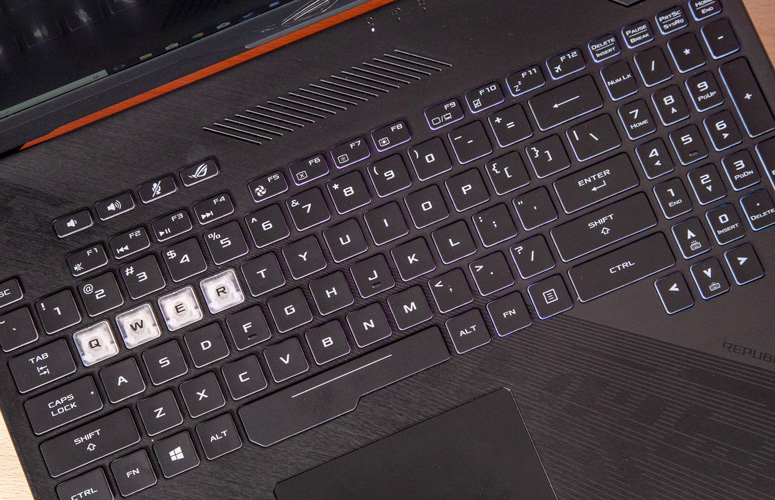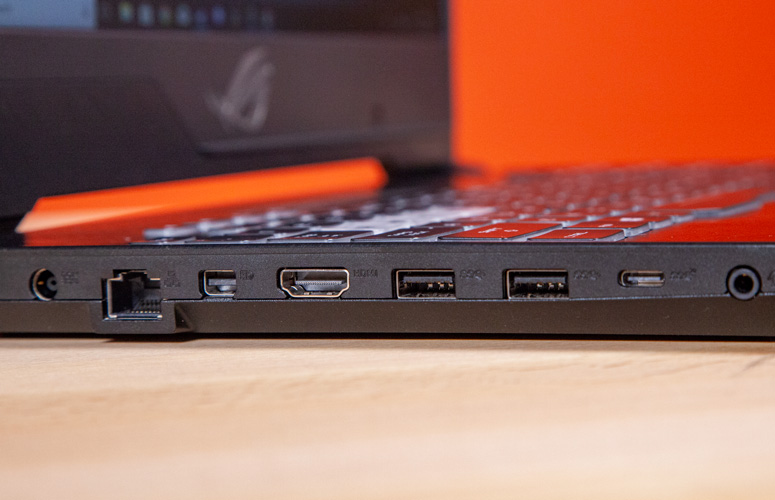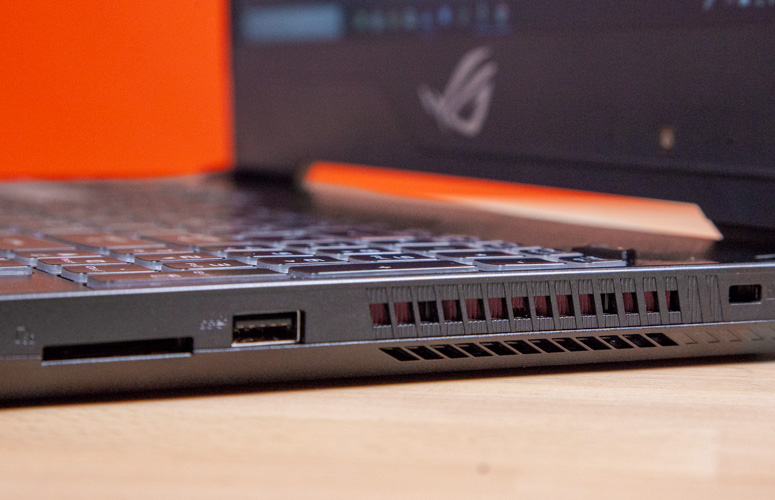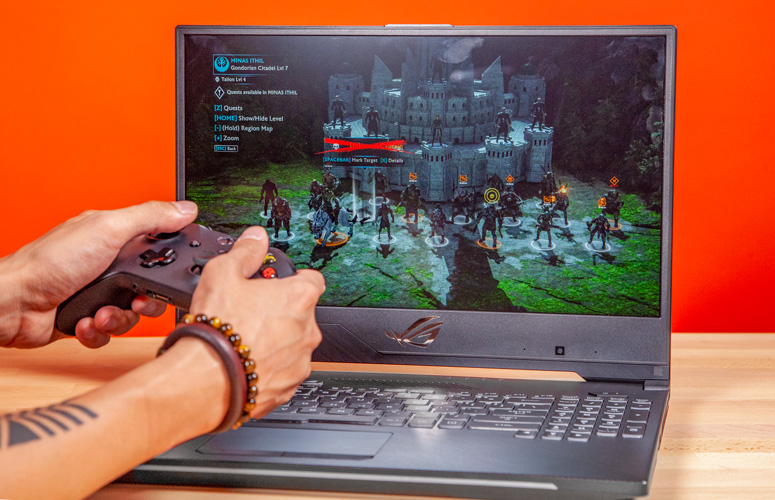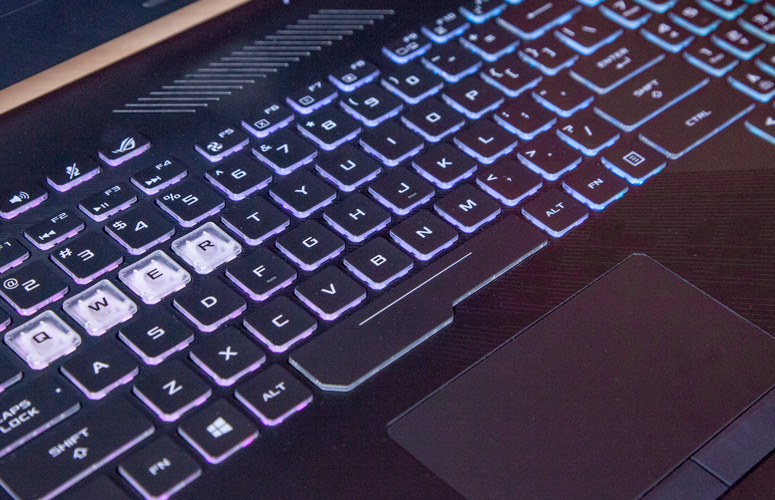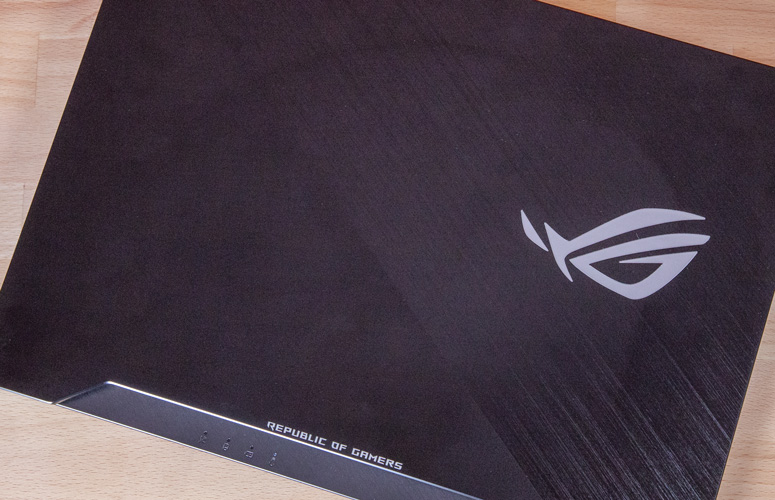Laptop Mag Verdict
The Asus ROG Strix Hero II is a sleek gaming laptop that bursts with power and captivates you with its sharp 144-Hz panel and intense speakers.
Pros
- +
Stylish design
- +
Vivid 144-Hz panel
- +
Excellent keyboard
- +
Awesome speakers
- +
Powerful performance
- +
Above-average battery life
Cons
- -
Webcam stares at your chin
- -
Bottom runs hot
Why you can trust Laptop Mag
Strap in and enjoy the ride. Asus' $1,915 (starting at $1,699) ROG Strix Hero II is the best asus laptop for gaming thanks to robust specs, including an 8th Gen Core i7 processor and GTX 1060 graphics. That means you'll have no problem playing the latest titles. This 15.6-inch beast will also blow you away with its colorful, 144-Hz panel and mesmerizing speakers.
The Strix Hero II does have a few flaws, including a ton of bloatware and an awkward camera located on the bottom bezel. But overall, this is a gaming rig you'll definitely want to own.
Design
The ROG Strix Hero II's black, aluminum lid is stylishly designed, with a slash representing the battle line in MOBA (multiplayer online battle arena) games. The upper-right section is elegantly hairline brushed, creating a satisfying sensation to the touch. It's also accompanied by an engraved, metallic-gray ROG logo that glows with RGB color. It's subtle enough not to be obnoxious.
The lower left is smoothly anodized and adorned with a white Republic of Gamers logo protruding near the hinge. The inner lid is exquisitely carved out, and the internal chassis features indicators for power, battery, hard drive and Wi-Fi. The vents in the back feature an ROG Strix logo and are edgily fashioned in red. Right before I opened the laptop, I saw an RGB light bar below the lid; it's a bit too gaudy for my taste, but it can be disabled.
The ROG Strix Hero II is subtle enough not to be obnoxious.
The internal, plastic chassis has a similar slash design, using gray-and-black paint to create a cyberpunk-style finish. The interior features an RGB-backlit keyboard that looks like something out of Metal Gear Solid, down to the exclamation point. The QWER keys are transparent, to make them stand out for MOBA players, which is pretty neat. Additionally, the touchpad has two discrete clickers. Above the keyboard lies a diagonal vent lid for the fan, and to the left are four distinguishable buttons for the audio sliders, microphone and ROG's Gaming Center.
I was particularly happy to find that the Hero II's bezels are practically nonexistent, though it means the webcam is awkwardly placed along the bottom bezel. The result is that other people will be gazing at your chin during video calls or Twitch streams.
Sign up to receive The Snapshot, a free special dispatch from Laptop Mag, in your inbox.
At 5.1 pounds and 14.2 x 10.3 x 1 inches, the ROG Strix Hero II is the thinnest and lightest mainstream gaming laptop among its competitors. The Acer Predator Helios 300 (15-inch) is the thickest, measuring 1.5 inches; the Lenovo Legion Y720 is the heaviest, weighing 6.8 pounds; and the PowerSpec 1510 fell in between, at 6.5 pounds and 1.3 inches thick.
Ports
The ROG Strix Hero II covers a wide selection of ports. Starting on the left, there's the power jack, an RJ45 port, a Mini DisplayPort, an HDMI 2.0 port, two USB 3.1 ports, one USB Type-C port and a headphone/microphone jack.
The right side features a Kensington lock slot, one USB 3.1 port and an SD memory reader.
Display
The ROG Strix Hero II's 15.6-inch, 1920 x 1080, 144-Hz panel is wonderfully bright and vivid, capturing each detail as it was meant to be represented.
I watched the trailer for Welcome to Marwen on the Hero II's display, and as an emotional Steve Carell sat in a courtroom, I was captivated by his crisp, glistening eyes. I noticed the stitching in his collared shirt and each strand of hair frizzing out of his head.
While playing Middle-earth: Shadow of War, I walked into the nook of a grassy-stone courtyard and was greeted by several muddy-looking orcs with sharp, wooden clubs. Every move I made to dodge and leap out of the way of their weapons was fluid and smooth, as if I had floated through time and space to slice their vibrant, green skin with my sharp, gold-trimmed blade. With their gory corpses laid out before me, I moved deeper into the sunlit courtyard and soaked in the details of each broken pillar and tattered blue-gold flag that hung over the castle walls as fiery ashes blew in the wind.
According to our testing, the Hero II's display covers a solid 120 percent of the sRGB color gamut, sliding past both the mainstream gaming laptop average and the PowerSpec 1510 (both 113 percent). It also soared by the Lenovo Legion Y720's 82 percent and the Acer Predator Helios 300's 88 percent.
MORE: Laptops with the Best Display Brightness
At 276 nits, the Hero II's screen is plenty bright, but it's still below the 308-nit category average. It's brighter than the Predator and the Legion, which averaged 226 and 210 nits, respectively. The PowerSpec also fell slightly below the average, at 306 nits.
Keyboard and Touchpad
Between its stylish design and responsiveness, the Hero II's island-style keyboard is quite the gem. The palm rests are incredibly soft, and I especially enjoyed the panache of the carved spacebar, which reminded me of Metal Gear's gritty aesthetic. Asus was smart to embed the arrow keys into the number pad, as the keys for Enter, Shift and Control are neatly aligned together.
With the keys being so well spaced, I nailed 66 words per minute on the 10fastfingers.com typing test, besting my 60-wpm average. The key travel is 1.4 millimeters, and the keys require 63 grams of actuation force. We typically look for travel in the 1.5-to-2.0-mm range and a minimum force of 60 grams.
The 4.2 x 2.3-inch touchpad is silky smooth, and its discrete clickers are very responsive. It recognized all the Windows 10 gestures I used.
Audio
The Hero II's speakers are so ferocious that my co-workers could hear Jonathan Young's "Unravel" beyond the closed doors of a large conference room. The gentle vocals that open the song are intended to be soft, but the speakers are so powerful, it sounded like I was at a concert.
The Hero II's speakers are so ferocious that my co-workers could hear Jonathan Young's 'Unravel' beyond the closed doors of a large conference room.
Once it got to the metal guitar section, I was blown away by the intensity of the bilateral sounds and how well the treble and bass weaved together during Young's guitar solo. The chorus exploded with crisp, heart-pounding audio, and when the end of the song closed with a sweet melodic tune, the desperation in Young's voice was captured perfectly.
When I played Shadow of War, I could easily hear how far I was from the intense catapult firing in the background. Every slash and dash in the fight against six orcs felt sharp and fierce, and after they all dropped, the sweet sound of sheathing my blade was so smooth it was music to my ears.
MORE: Help Me, Laptop: I Need a Laptop with Dual Audio Jacks
The Hero II's awesome sound is enhanced by the Sonic Studio III app, which comes with a customizable equalizer as well as preset settings such as Bright, Deep, Deep and Bright, Dynamic, and Lively.
Gaming, Graphics and VR
The Hero II's Nvidia GeForce GTX 1060 GPU, with 6GB of VRAM, ran Shadow of War at a smooth 61 frames per second on very high settings as I invaded an orc outpost on the hunt for revenge against Norsko, a berserker who murdered me while I was writing my audio blurb. I fluidly swiped and dodged surrounding orcs without a single frame-rate dip for several minutes, until another Captain showed up and quickly overwhelmed and killed me. My death looked velvety smooth, though.
Rise of the Tomb Raider ran at 38 fps on very high and 1080p, and while that's above the 34-fps category average, other laptops have fared better. The Acer Predator Helios 300 (GTX 1060 6GB) ran the game the best, at 67 fps, and the PowerSpec 1510 (GTX 1070 8GB) was close behind, at 56 fps. The Lenovo Legion Y720 (GTX 1060 6GB) was the slowest, at 35 fps. (We consider anything above 30 fps to be playable.)
On the Hitman benchmark (1080p, ultra), the Hero II maintained a very smooth 72 fps, beating the 67-fps category average. The Predator (64 fps), Legion (62 fps) and PowerSpec (60 fps) all fell behind the Hero II and the average.
Grand Theft Auto V ran at 52 fps on very high and 1080p, falling slightly under the 56-fps category average and the PowerSpec's 60 fps. The Legion and the Predator averaged 47 and 49 fps, respectively.
The Hero II scored a solid 7.4 out of 11 on the SteamVR Performance test, surpassing the 5.5 category average as well as the Legion's 6.7 and the Predator's 7.1. The PowerSpec, however, scored a perfect 11.]
MORE: Best Graphics Performance
The Hero II also comes with an Intel UHD 630 graphics card built in for those moments when you just want to watch a video or do some actual work.
Performance
This baby roars with power. The Hero II can run Shadow of War like a champ, stream your favorite Spotify playlist and manage over 40 Google Chrome tabs filled with more wikis than you need all at the same time. The laptop gets that fiery horsepower from its Intel Core i7-8750H processor, 32GB of RAM, 256GB NVMe SSD, and 1TB, 5,400-rpm HDD.
On the Geekbench 4 overall performance test, the ROG Strix Hero II scored an amazing 20,690, skyrocketing over the 15,676 mainstream gaming laptop average. The Lenovo Legion Y720 (12,169), the Acer Predator Helios 300 (13,587) and the PowerSpec 1510 (14,223) all fell below the category average, with their respective Intel Core i7-7700HQ processors.
It took the Hero II 11 seconds to copy 4.97GB of multimedia files, translating to a whopping 462 megabytes per second. That's higher than the 323MBps category average as well as the PowerSpec's 391MBps. The Predator and the Legion were a little slower, at 188 and 164MBps, respectively.
On our HandBrake test, the Hero II took 9 minutes and 36 seconds to transcode a 4K video to 1080p, knocking out the 12:21 category average and the PowerSpec's 14:00.
MORE: Laptops with the Best Productivity Performance
The Hero II took 35 seconds to match 65,000 names and addresses on our Excel test, once again speeding past the category average (0:48) and the PowerSpec (1:08).
Battery Life
The ROG Strix Hero II put up a good fight, especially for a gaming laptop. Its battery lasted 4 hours and 56 minutes while continuously web surfing over Wi-Fi at 150 nits of screen brightness, crushing the 3:17 mainstream gaming laptop average. However, both the Acer Predator Helios 300 and the Lenovo Legion Y720 lasted just over 6 hours.
Webcam
In an effort to make the bezels thin, Asus placed the Hero II's webcam along the bottom bezel, where it looks directly at your chin. And it looks as awkward as you can imagine. Even if its weird location weren't an issue, there was another problem: The webcam took dark and grainy images. My hair looked like a 5-year-old drew it on, although the colors weren't too bad. The shades of gray, white and blue were decently represented on my flannel shirt, and the lights on the ceiling weren't blown out. But ultimately, the images looked very unpleasant.
Heat
After we played Shadow of War for 15 minutes, the Hero II's underside measured 110 degrees Fahrenheit, climbing above our 95-degree comfort threshold. The center of the keyboard and touchpad measured 100 and 79 degrees, respectively. The hottest point was close to the center of the hinge, which hit 120 degrees. Despite that, I wasn't uncomfortable while I was gaming at home with the Hero II on my lap.
In fact, the Hero II still climbed above our threshold even when it wasn't gaming. After we streamed a 15-minute HD video, the underside climbed to 103 degrees. The center of the keyboard hit a more reasonable 92 degrees, and the touchpad registered a cool 79 degrees.
Software and Warranty
Asus offers several of its own apps for the Republic of Gamers. The Gaming Center highlights the CPU and GPU specs, clock speed, temps and memory, as well as provides options for freeing up memory. Below the interface are shortcuts for other ROG apps and settings for the fan speed, touchpad, Windows key and ROG key. The Aura Core app controls the RGB backlighting, and GameVisual features multiple settings to change the panel's color and brightness.
GameFirst V has fully customizable Wi-Fi options to manage gameplay as well as other activities. Sonic Radar III displays a radar on-screen to visualize which direction audio is coming from, specifically for gamers looking for an edge. Sonic Studio III enhances capabilities for streaming and audio recording through various settings. There's also the XSplit Gamecaster for live streaming, as well as the Asus Gift Box, which allows you to buy select programs, such as Adobe Acrobat Pro, at Asus-exclusive discounts. There's a customer support app called MyAsus, as well as an antivirus app McAfee Security.
MORE: Asus Goes All-in with eSports with Strix and Scar II Gaming Laptops
Like most Windows 10 machines, the Strix Hero II features tons of Microsoft-supplied bloatware, such as Cooking Fever, Candy Crush Saga, Netflix and Asphalt Street Storm Racing.
The ROG Strix Hero II comes with a one-year limited warranty. See how Asus performed on our Tech Support Showdown and Best and Worst Brands ranking.
Configurations
The ROG Strix Hero II that I tested isn't technically a retail model, as it has 32GB of RAM instead of 16GB. We found this configuration on Amazon, and it costs $1,915. However, the base model costs $1,699 and comes with an Intel Core i7-8750H processor; 16GB of RAM; a 256GB NVMe SSD; a 1TB, 5,400-rpm HDD; and an Nvidia GTX 1060 6GB graphics card.
Bottom Line
Asus' ROG Strix Hero II ($1,915) is an absolute beaut of a gaming laptop. It's thinner and lighter than competitors and still manages to pack intense firepower, and provides plenty of immersion with its immaculate display and heart-pounding speakers. The high amount of bloatware and awkward webcam might stamp out some of your fun, though.
If you're looking for a brighter display, better battery life and stronger graphics, the PowerSpec 1510 ($1,299) is an excellent alternative, especially if you want to play in VR. However, that system is considerably heavier than the Asus, its speakers are relatively quiet, it provides no helpful gaming utilities and its bezels are considerably bigger.
Overall, the Hero II's solid battery life, awesome keyboard and impressive overall performance make it an excellent choice for gaming on the go.
Credit: Laptop Mag
- Best Gaming Laptops (Including VR-Ready Gaming Laptops)
- Here Are the Best Gaming Laptops Under $1,000: Edition
- Should You Buy a Budget Gaming Laptop, a High-End Laptop or an ...
Strap in and enjoy the ride. Asus' $1,915 (starting at $1,699) ROG Strix Hero II is a gaming laptop that boasts some robust specs, including an 8th Gen Core i7 processor and GTX 1060 graphics. That means you'll have no problem playing the latest titles. This 15.6-inch beast will also blow you away with its colorful, 144-Hz panel and mesmerizing speakers.
The Strix Hero II does have a few flaws, including a ton of bloatware and an awkward camera located on the bottom bezel. But overall, this is a gaming rig you'll definitely want to own.
Design
The ROG Strix Hero II's black, aluminum lid is stylishly designed, with a slash representing the battle line in MOBA (multiplayer online battle arena) games. The upper-right section is elegantly hairline brushed, creating a satisfying sensation to the touch. It's also accompanied by an engraved, metallic-gray ROG logo that glows with RGB color. It's subtle enough not to be obnoxious.
The lower left is smoothly anodized and adorned with a white Republic of Gamers logo protruding near the hinge. The inner lid is exquisitely carved out, and the internal chassis features indicators for power, battery, hard drive and Wi-Fi. The vents in the back feature an ROG Strix logo and are edgily fashioned in red. Right before I opened the laptop, I saw an RGB light bar below the lid; it's a bit too gaudy for my taste, but it can be disabled.
The ROG Strix Hero II is subtle enough not to be obnoxious.
The internal, plastic chassis has a similar slash design, using gray-and-black paint to create a cyberpunk-style finish. The interior features an RGB-backlit keyboard that looks like something out of Metal Gear Solid, down to the exclamation point. The QWER keys are transparent, to make them stand out for MOBA players, which is pretty neat. Additionally, the touchpad has two discrete clickers. Above the keyboard lies a diagonal vent lid for the fan, and to the left are four distinguishable buttons for the audio sliders, microphone and ROG's Gaming Center.
I was particularly happy to find that the Hero II's bezels are practically nonexistent, though it means the webcam is awkwardly placed along the bottom bezel. The result is that other people will be gazing at your chin during video calls or Twitch streams.
At 5.1 pounds and 14.2 x 10.3 x 1 inches, the ROG Strix Hero II is the thinnest and lightest mainstream gaming laptop among its competitors. The Acer Predator Helios 300 (15-inch) is the thickest, measuring 1.5 inches; the Lenovo Legion Y720 is the heaviest, weighing 6.8 pounds; and the PowerSpec 1510 fell in between, at 6.5 pounds and 1.3 inches thick.
Ports
The ROG Strix Hero II covers a wide selection of ports. Starting on the left, there's the power jack, an RJ45 port, a Mini DisplayPort, an HDMI 2.0 port, two USB 3.1 ports, one USB Type-C port and a headphone/microphone jack.
The right side features a Kensington lock slot, one USB 3.1 port and an SD memory reader.
Display
The ROG Strix Hero II's 15.6-inch, 1920 x 1080, 144-Hz panel is wonderfully bright and vivid, capturing each detail as it was meant to be represented.
I watched the trailer for Welcome to Marwen on the Hero II's display, and as an emotional Steve Carell sat in a courtroom, I was captivated by his crisp, glistening eyes. I noticed the stitching in his collared shirt and each strand of hair frizzing out of his head.
While playing Middle-earth: Shadow of War, I walked into the nook of a grassy-stone courtyard and was greeted by several muddy-looking orcs with sharp, wooden clubs. Every move I made to dodge and leap out of the way of their weapons was fluid and smooth, as if I had floated through time and space to slice their vibrant, green skin with my sharp, gold-trimmed blade. With their gory corpses laid out before me, I moved deeper into the sunlit courtyard and soaked in the details of each broken pillar and tattered blue-gold flag that hung over the castle walls as fiery ashes blew in the wind.
According to our testing, the Hero II's display covers a solid 120 percent of the sRGB color gamut, sliding past both the mainstream gaming laptop average and the PowerSpec 1510 (both 113 percent). It also soared by the Lenovo Legion Y720's 82 percent and the Acer Predator Helios 300's 88 percent.
MORE: Laptops with the Best Display Brightness
At 276 nits, the Hero II's screen is plenty bright, but it's still below the 308-nit category average. It's brighter than the Predator and the Legion, which averaged 226 and 210 nits, respectively. The PowerSpec also fell slightly below the average, at 306 nits.
Keyboard and Touchpad
Between its stylish design and responsiveness, the Hero II's island-style keyboard is quite the gem. The palm rests are incredibly soft, and I especially enjoyed the panache of the carved spacebar, which reminded me of Metal Gear's gritty aesthetic. Asus was smart to embed the arrow keys into the number pad, as the keys for Enter, Shift and Control are neatly aligned together.
With the keys being so well spaced, I nailed 66 words per minute on the 10fastfingers.com typing test, besting my 60-wpm average. The key travel is 1.4 millimeters, and the keys require 63 grams of actuation force. We typically look for travel in the 1.5-to-2.0-mm range and a minimum force of 60 grams.
The 4.2 x 2.3-inch touchpad is silky smooth, and its discrete clickers are very responsive. It recognized all the Windows 10 gestures I used.
Audio
The Hero II's speakers are so ferocious that my co-workers could hear Jonathan Young's "Unravel" beyond the closed doors of a large conference room. The gentle vocals that open the song are intended to be soft, but the speakers are so powerful, it sounded like I was at a concert.
The Hero II's speakers are so ferocious that my co-workers could hear Jonathan Young's 'Unravel' beyond the closed doors of a large conference room.
Once it got to the metal guitar section, I was blown away by the intensity of the bilateral sounds and how well the treble and bass weaved together during Young's guitar solo. The chorus exploded with crisp, heart-pounding audio, and when the end of the song closed with a sweet melodic tune, the desperation in Young's voice was captured perfectly.
When I played Shadow of War, I could easily hear how far I was from the intense catapult firing in the background. Every slash and dash in the fight against six orcs felt sharp and fierce, and after they all dropped, the sweet sound of sheathing my blade was so smooth it was music to my ears.
MORE: Help Me, Laptop: I Need a Laptop with Dual Audio Jacks
The Hero II's awesome sound is enhanced by the Sonic Studio III app, which comes with a customizable equalizer as well as preset settings such as Bright, Deep, Deep and Bright, Dynamic, and Lively.
Gaming, Graphics and VR
The Hero II's Nvidia GeForce GTX 1060 GPU, with 6GB of VRAM, ran Shadow of War at a smooth 61 frames per second on very high settings as I invaded an orc outpost on the hunt for revenge against Norsko, a berserker who murdered me while I was writing my audio blurb. I fluidly swiped and dodged surrounding orcs without a single frame-rate dip for several minutes, until another Captain showed up and quickly overwhelmed and killed me. My death looked velvety smooth, though.
Rise of the Tomb Raider ran at 38 fps on very high and 1080p, and while that's above the 34-fps category average, other laptops have fared better. The Acer Predator Helios 300 (GTX 1060 6GB) ran the game the best, at 67 fps, and the PowerSpec 1510 (GTX 1070 8GB) was close behind, at 56 fps. The Lenovo Legion Y720 (GTX 1060 6GB) was the slowest, at 35 fps. (We consider anything above 30 fps to be playable.)
On the Hitman benchmark (1080p, ultra), the Hero II maintained a very smooth 72 fps, beating the 67-fps category average. The Predator (64 fps), Legion (62 fps) and PowerSpec (60 fps) all fell behind the Hero II and the average.
Grand Theft Auto V ran at 52 fps on very high and 1080p, falling slightly under the 56-fps category average and the PowerSpec's 60 fps. The Legion and the Predator averaged 47 and 49 fps, respectively.
The Hero II scored a solid 7.4 out of 11 on the SteamVR Performance test, surpassing the 5.5 category average as well as the Legion's 6.7 and the Predator's 7.1. The PowerSpec, however, scored a perfect 11.
MORE: Best Graphics Performance
The Hero II also comes with an Intel UHD 630 graphics card built in for those moments when you just want to watch a video or do some actual work.
Performance
This baby roars with power. The Hero II can run Shadow of War like a champ, stream your favorite Spotify playlist and manage over 40 Google Chrome tabs filled with more wikis than you need all at the same time. The laptop gets that fiery horsepower from its Intel Core i7-8750H processor, 32GB of RAM, 256GB NVMe SSD, and 1TB, 5,400-rpm HDD.
On the Geekbench 4 overall performance test, the ROG Strix Hero II scored an amazing 20,690, skyrocketing over the 15,676 mainstream gaming laptop average. The Lenovo Legion Y720 (12,169), the Acer Predator Helios 300 (13,587) and the PowerSpec 1510 (14,223) all fell below the category average, with their respective Intel Core i7-7700HQ processors.
It took the Hero II 11 seconds to copy 4.97GB of multimedia files, translating to a whopping 462 megabytes per second. That's higher than the 323MBps category average as well as the PowerSpec's 391MBps. The Predator and the Legion were a little slower, at 188 and 164MBps, respectively.
On our HandBrake test, the Hero II took 9 minutes and 36 seconds to transcode a 4K video to 1080p, knocking out the 12:21 category average and the PowerSpec's 14:00.
MORE: Laptops with the Best Productivity Performance
The Hero II took 35 seconds to match 65,000 names and addresses on our Excel test, once again speeding past the category average (0:48) and the PowerSpec (1:08).
Battery Life
The ROG Strix Hero II put up a good fight, especially for a gaming laptop. Its battery lasted 4 hours and 56 minutes while continuously web surfing over Wi-Fi at 150 nits of screen brightness, crushing the 3:17 mainstream gaming laptop average. However, both the Acer Predator Helios 300 and the Lenovo Legion Y720 lasted just over 6 hours.
Webcam
In an effort to make the bezels thin, Asus placed the Hero II's webcam along the bottom bezel, where it looks directly at your chin. And it looks as awkward as you can imagine. Even if its weird location weren't an issue, there was another problem: The webcam took dark and grainy images. My hair looked like a 5-year-old drew it on, although the colors weren't too bad. The shades of gray, white and blue were decently represented on my flannel shirt, and the lights on the ceiling weren't blown out. But ultimately, the images looked very unpleasant.
Heat
After we played Shadow of War for 15 minutes, the Hero II's underside measured 110 degrees Fahrenheit, climbing above our 95-degree comfort threshold. The center of the keyboard and touchpad measured 100 and 79 degrees, respectively. The hottest point was close to the center of the hinge, which hit 120 degrees. Despite that, I wasn't uncomfortable while I was gaming at home with the Hero II on my lap.
MORE: Longest Battery Life Laptops
In fact, the Hero II still climbed above our threshold even when it wasn't gaming. After we streamed a 15-minute HD video, the underside climbed to 103 degrees. The center of the keyboard hit a more reasonable 92 degrees, and the touchpad registered a cool 79 degrees.
Software and Warranty
Asus offers several of its own apps for the Republic of Gamers. The Gaming Center highlights the CPU and GPU specs, clock speed, temps and memory, as well as provides options for freeing up memory. Below the interface are shortcuts for other ROG apps and settings for the fan speed, touchpad, Windows key and ROG key. The Aura Core app controls the RGB backlighting, and GameVisual features multiple settings to change the panel's color and brightness.
GameFirst V has fully customizable Wi-Fi options to manage gameplay as well as other activities. Sonic Radar III displays a radar on-screen to visualize which direction audio is coming from, specifically for gamers looking for an edge. Sonic Studio III enhances capabilities for streaming and audio recording through various settings. There's also the XSplit Gamecaster for live streaming, as well as the Asus Gift Box, which allows you to buy select programs, such as Adobe Acrobat Pro, at Asus-exclusive discounts. There's a customer support app called MyAsus, as well as an antivirus app McAfee Security.
MORE: Asus Goes All-in with eSports with Strix and Scar II Gaming Laptops
Like most Windows 10 machines, the Strix Hero II features tons of Microsoft-supplied bloatware, such as Cooking Fever, Candy Crush Saga, Netflix and Asphalt Street Storm Racing.
The ROG Strix Hero II comes with a one-year limited warranty. See how Asus performed on our Tech Support Showdown and Best and Worst Brands ranking.
Configurations
The ROG Strix Hero II that I tested isn't technically a retail model, as it has 32GB of RAM instead of 16GB. We found this configuration on Amazon, and it costs $1,915. However, the base model costs $1,699 and comes with an Intel Core i7-8750H processor; 16GB of RAM; a 256GB NVMe SSD; a 1TB, 5,400-rpm HDD; and an Nvidia GTX 1060 6GB graphics card.
Bottom Line
Asus' ROG Strix Hero II ($1,915) is an absolute beaut of a gaming laptop. It's thinner and lighter than competitors and still manages to pack intense firepower, and provides plenty of immersion with its immaculate display and heart-pounding speakers. The high amount of bloatware and awkward webcam might stamp out some of your fun, though.
If you're looking for a brighter display, better battery life and stronger graphics, the PowerSpec 1510 ($1,299) is an excellent alternative, especially if you want to play in VR. However, that system is considerably heavier than the Asus, its speakers are relatively quiet, it provides no helpful gaming utilities and its bezels are considerably bigger.
Overall, the Hero II's solid battery life, awesome keyboard and impressive overall performance make it an excellent choice for gaming on the go.
Credit: Laptop Mag
- Best Gaming Laptops (Including VR-Ready Gaming Laptops)
- Here Are the Best Gaming Laptops Under $1,000: Edition
- Should You Buy a Budget Gaming Laptop, a High-End Laptop or an ...
Asus ROG Strix Hero II (GL504GM) Specs
| Bluetooth | Bluetooth 5.0 |
| Brand | ASUS |
| CPU | 2.2-GHz Intel Core i7-8750H |
| Card Slots | SD memory reader |
| Company Website | https://www.asus.com/us/ |
| Display Size | 15.6 |
| Graphics Card | Nvidia GeForce GTX 1060 6GB |
| Hard Drive Size | 256GB SSD |
| Hard Drive Type | M.2 PCIe NVMe SSD |
| Highest Available Resolution | 1920 x 1080 |
| Native Resolution | 1920x1080 |
| Operating System | Windows 10 Pro |
| Ports (excluding USB) | Kensington Lock, Mini Display Port, RJ-45, USB Type-C, SD card slot, USB 3.1, HDMI 2.0, Headphone/Mic |
| RAM | 32GB |
| RAM Upgradable to | 32GB |
| Secondary Hard Drive Size | 1TB |
| Secondary Hard Drive Speed | 5400 RPM |
| Secondary Hard Drive Type | HDD |
| Size | 14.2 x 10.3 x 1 inches |
| Touchpad Size | 4.2 x 2.3 inches |
| USB Ports | 4 |
| Video Memory | 6 GB |
| Warranty/Support | One-year limited warranty |
| Weight | 5.1 pounds |
| Wi-Fi | 802.11ac |
| Wi-Fi Model | 2x2 Wave 2 WLAN |

Rami Tabari is the Reviews Editor for Laptop Mag. He reviews every shape and form of a laptop as well as all sorts of cool tech. You can find him sitting at his desk surrounded by a hoarder's dream of laptops, and when he navigates his way out to civilization, you can catch him watching really bad anime or playing some kind of painfully difficult game. He’s the best at every game and he just doesn’t lose. That’s why you’ll occasionally catch his byline attached to the latest Souls-like challenge.

